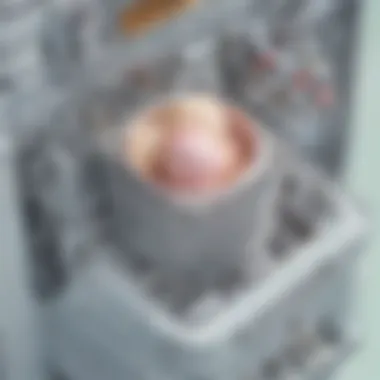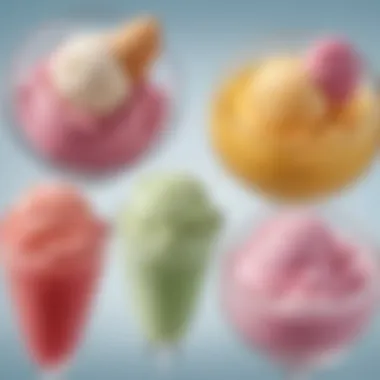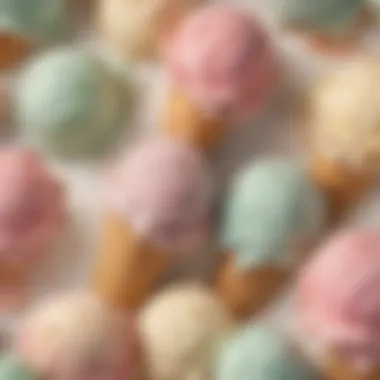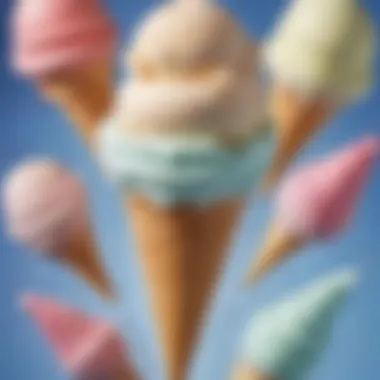Understanding Ice Cream Makers: Science and Mechanics


Intro
Ice cream is a favored treat around the world, often bringing joy to people of all ages. But have you ever thought about how this creamy delight is made? Understanding the mechanics behind ice cream makers reveals not just culinary artistry but also the fundamental principles of science. From mixing ingredients to the freezing process, each step is crucial to achieving that perfect scoop. This article will explore the components and mechanisms of ice cream makers. Together, we will uncover the intertwining of scientific concepts with the culinary world.
Science Fun Facts
Ice cream has a rich history and some surprising characteristics. Here are notable facts that might pique your curiosity:
- The Origin: Ice cream dates back to ancient China, where a mixture of milk and rice was frozen in snow.
- World Records: The largest ice cream cake ever created weighed over 3,000 pounds and was made in 2011 in Alberta, Canada.
- Flavors Galore: While vanilla and chocolate lead as popular flavors, some chefs have experimented with bizarre options like wasabi or even garlic!
"Science is not only compatible with spirituality; it is a profound source of spirituality." – Carl Sagan
The Role of Components in Ice Cream Makers
Understanding what makes ice cream makers tick requires examining their individual components. Each part serves a specific function.
- Base Ingredients: Milk, sugar, cream, and flavorings. The combination forms the foundation of the ice cream mixture.
- Churning Mechanism: This part mixes the ingredients, incorporating air. This process leads to a smoother texture.
- Freezing Mechanism: Different machines use varying methods. Some utilize salt and ice, while others have integrated freezing bowls. The objective is to lower the temperature rapidly enough to create uniform ice crystals.
Discover the Wonders of Science
The science involved in making ice cream goes beyond just its ingredients and machinery. Here are some concepts worth exploring:
- Thermodynamics: The principles of heat transfer and phase changes are essential in the freezing process. The smoother the mixture, the better the final product.
- Emulsification: This is the process of blending fat and water. Proper emulsification ensures consistency in your ice cream.
Educational Tools
For those curious about these scientific concepts, various resources offer interactive learning experiences. Websites like Britannica provide detailed articles and videos explaining these phenomena in simpler terms.
Science Experiment Showcase
For young enthusiasts, conducting simple experiments can foster understanding. Here’s a straightforward ice cream-making experiment that illustrates these principles:
Materials Needed
- 1 cup of heavy cream
- 1 cup of milk
- 3/4 cup of sugar
- 1 teaspoon of vanilla extract
- Ice and salt (for freezing)
Step-By-Step Instructions
- Mix cream, milk, sugar, and vanilla in a bowl until combined.
- Pour the mixture into a bag, sealing it tightly.
- Fill a larger bag halfway with ice and add salt. Place the smaller bag inside.
- Shake the larger bag for about 10-15 minutes.
- Carefully remove the small bag, rinse it, and serve your homemade ice cream.
Safety Tips
- Make sure the bags are securely sealed to prevent any leaks.
- Be careful when handling ice and salt to avoid skin irritation.
Culmination
This exploration into the workings of ice cream makers highlights not only the culinary skills involved but also the underlying scientific principles. By bridging these two worlds, we appreciate ice cream not merely as a delicious treat but also as a product of fascinating science. Through experiments and inquiries, young minds can engage with the wonders of science, enabling them to discover new possibilities in the kitchen.
Preface to Ice Cream Making
Ice cream making is an art form that blends history, culture, and science. It serves not only as a method to create a beloved frozen dessert but also functions as a vehicle for important lessons in food technology. Understanding the intricacies of ice cream production enhances our appreciation of this treat, while also fostering a curiosity about the underlying scientific principles.
The exploration of ice cream making introduces various components, like the churning mechanism, mixing bowl, and cooling elements. Each of these components plays a significant role in transforming simple ingredients into a smooth, creamy dessert. Learning about the mechanisms behind ice cream makers is more than just understanding how to whip up a tasty dessert – it opens doors to concepts in thermodynamics and chemistry.
By examining the past of ice cream, along with its cultural relevance, we unveil a rich narrative that emphasizes the importance of this dessert through time. Understanding the journey of ice cream from its inception to its current status provides valuable insights not only into culinary arts but also into societal shifts and technological advancements.
Historical Perspective
Ice cream has a long history that stretches back to ancient civilizations. The earliest forms of ice cream can be traced back to the Chinese, who used ice and milk to create a frozen dessert as early as 200 B.C. In addition, Roman emperors enjoyed soft, icy confections made of snow and wine. Over the centuries, ice cream recipes continued to evolve, with the invention of mechanical ice cream makers in the 18th century marking a pivotal moment. This technological progress made ice cream more accessible to the public.
The introduction of the first commercial ice cream machine by Nancy Johnson in 1843 revolutionized ice cream production. This machine allowed people to make ice cream at home more efficiently. The popularity of ice cream soared, leading to ice cream parlors sprouting in cities across Europe and America by the late 19th century.
Significance of Ice Cream in Culture
Ice cream holds a unique position in our cultural landscape. Its presence spans diverse regions and functions as a symbol of celebration and comfort. Throughout history, ice cream has been linked to various social occasions, from birthday parties to cultural festivals. The flavors, ingredients, and even the methods of making ice cream differ across cultures, reflecting the diversity of culinary traditions.
In communities worldwide, ice cream represents moments of joy and togetherness. As families gather to enjoy a scoop on a hot day or during special events, it fosters connections among people. The shared experience of savoring ice cream transcends age, creating a universal appreciation for this delightful treat.
In essence, the journey into the world of ice cream makers is not just a descent into gastronomy, but an exploration of its historical and cultural significance. This engagement with ice cream at various levels enhances our understanding of both science and society.
Basic Principles of Ice Cream Production
The production of ice cream combines art and science. Understanding the basic principles of ice cream production is crucial not just for making a delicious dessert, but also for comprehending the underlying mechanisms that lead to its characteristic texture and flavor. This section covers two essential subtopics: freezing point depression and the role of fat and sugar in achieving creaminess. Each component of this process plays a significant role in defining the final product.


Ice cream production is ultimately affected by temperature and consistency. The temperature at which ice cream freezes directly influences its texture. The right balance of ingredients is also critical; finding the optimal ratios of fat and sugar can transform a basic mix into a rich and creamy dessert. Understanding these elements provides insight into the delicate balance needed for successful ice cream making.
Understanding Freezing Point Depression
Freezing point depression refers to the phenomenon where the addition of solutes, such as sugar or salt, lowers the freezing point of a solvent, like water. In the context of ice cream, this principle is vital because it determines how smoothly the ice cream freezes. The main purpose of this is to prevent the water in the mixture from freezing solid, which would result in a hard, less enjoyable texture.
When sugar is added to the cream mixture, it disrupts the formation of ice crystals by requiring a lower temperature to achieve freezing. The result is a softer and creamier consistency, as it yields smaller ice crystals compared to a sugar-less concoction. Thus, the careful measurement of sugar in the recipe is essential.
Understanding freezing point depression not only aids in creating a smooth final product but also highlights the role of temperature management during the freezing process. If the mixture gets too cold too quickly, large ice crystals can form, which can ruin the texture of the ice cream.
Role of Fat and Sugar in Creaminess
The interaction between fat and sugar is central to the creaminess and mouthfeel of ice cream. Fat, typically sourced from dairy products, contributes to richness. It creates a velvety texture by coating the taste buds and enhancing the overall flavor experience. Cream, butter, and milk fat play a significant part here. Higher fat content usually results in a creamier product.
On the other hand, sugar not only lowers the freezing point but also enhances flavor and interacts with the fat to create a smooth texture. The balance of these two components is critical. If there is too much sugar, the ice cream can become overly soft; too little can lead to a hard texture with larger ice crystals.
This interplay forms the foundation of enjoyable ice cream. It requires careful experimentation and precise calculations to discover the perfect ratio that achieves a soft, delicious, and creamy dessert.
"The art of ice cream making lies in balancing the principles of freezing point depression and the roles of fat and sugar. The right mix makes for a delightful experience."
Components of an Ice Cream Maker
The components of an ice cream maker are crucial to its functionality. Understanding these parts helps in appreciating how they work together to create that smooth and creamy delight called ice cream. Each element contributes to specific functions that enhance the overall ice cream-making process. This section discusses three key components: the mixing bowl, the churning mechanism, and the cooling element. Each part plays a vital role in transforming liquid ingredients into frozen dessert.
Mixing Bowl
The mixing bowl is where the magic begins. It holds the mixture of cream, sugar, and flavorings before the freezing starts. The material of the mixing bowl can affect the temperature and consistency of the ice cream. Typically, bowls made of stainless steel or plastic are used. Stainless steel is good because it conducts cold well, which helps during the freezing process.
When preparing the mixture, it is important to thoroughly combine the ingredients. This not only ensures a unified flavor but also assists in the overall texture of the final product. If some ingredients remain unmixed, it can lead to varying textures in the ice cream, causing graininess rather than a smooth feel.
The size of the mixing bowl also matters. A larger bowl allows for more mixture, which can be useful for making multiple servings of ice cream. However, it is essential to consider how much space the ice cream maker has available. This consideration can save time when cleaning and storing the equipment.
Churning Mechanism
The churning mechanism is another key feature of an ice cream maker. As the ice cream mixture is chilled, it is continuously stirred or churned. This process incorporates air into the mixture, creating that desired light and frothy texture. Without churning, the ice cream would end up dense and icy, lacking the creamy quality that many enjoy.
There are various designs for churning mechanisms. Some ice cream makers use a paddle that spins, while others may use a combination of paddles and scraping tools to ensure even mixing. The speed of the churning can also impact the texture. Faster churning incorporates more air, which can lead to a lighter consistency.
The effectiveness of the churning mechanism will influence the final ice cream quality. Therefore, selecting a maker with a good churning system is essential for ice cream enthusiasts hoping to achieve a delightful dessert.
Cooling Element
The cooling element is fundamental to the freezing phase of ice cream making. This component works by absorbing heat from the mixture, lowering its temperature until it reaches the desired solid state. In most electric ice cream makers, this is facilitated by a compressor, which circulates cold air or coolant around the mixing bowl.
There are different types of cooling elements. Some makers rely on ice and salt mixtures, while others utilize built-in freezers. Each method has its advantages and drawbacks. For example, models using ice and salt require more manual effort and planning, as the ice must be prepared in advance. Conversely, compressor-cooled machines can make ice cream in one go, but they may come at a higher cost.
Overall, the cooling element is perhaps the most important feature. The effectiveness of freezing directly correlates with the texture and flavor. A well-functioning cooling element ensures that ice cream freezes quickly, allowing for fewer ice crystals and a creamier end product.
Effective component integration leads to superior ice cream quality.
Types of Ice Cream Makers
Understanding the various types of ice cream makers is crucial for anyone interested in producing their own frozen dessert. Each type offers unique features, benefits, and considerations that cater to different preferences and needs. Whether one seeks simplicity, speed, or advanced technology, choosing the right ice cream maker can impact the quality and texture of the final product. Below, we will discuss three main categories: manual, electric, and compressor-cooled models.
Manual Ice Cream Makers
Manual ice cream makers represent a classic approach to the art of ice cream making. These devices often require a bit of effort but can be quite rewarding for those who appreciate hands-on activities. With a manual model, the user typically has to crank a handle to churn the mixture. This process allows for greater control over the texture and consistency.
- Benefits:
- Considerations:
- No electricity required.
- Great for engaging kids.
- Can produce high-quality ice cream with the right technique.
- Requires physical effort which may not suit everyone.
- Takes more time compared to electric models.
Many families find joy in the tradition of using a manual ice cream maker, making it a delightful activity to perform together. However, the effort involved is worth considering, especially for those who might prefer a more automated experience.
Electric Ice Cream Makers
Electric ice cream makers streamline the process, making it suitable for those who desire convenience without sacrificing quality. These machines often come with built-in motors to handle the mixing and churning, significantly reducing the labor involved in producing ice cream. Electric models typically feature a bowl that must be pre-frozen, which helps create the perfect creamy texture.
- Benefits:
- Considerations:
- Less physical strain, making it accessible for all ages.
- Typically produces ice cream faster compared to manual models.
- Allows for more consistent results due to automated churning.
- Must ensure the bowl is frozen ahead of time, which can require planning.
- Dependent on electricity, limiting use in certain situations.


Electric ice cream makers are popular for making ice cream on warm days or for parties. Their efficiency can be appealing to busy parents, ensuring everyone enjoys their treat with little hassle.
Compressor-Cooled Models
Compressor-cooled ice cream makers represent the pinnacle of home ice cream technology. These machines are self-contained and can freeze the mixture while simultaneously churning it. This type of ice cream maker eliminates the need for pre-frozen bowls, allowing users to create ice cream anytime they wish.
- Benefits:
- Considerations:
- Instant gratification—can make ice cream on demand.
- Consistent freezing and churning deliver a smooth texture.
- Ability to experiment with different flavors and recipes easily.
- Generally more expensive than other types of ice cream makers.
- Require more counter space due to their size.
Compressor-cooled models are ideal for serious ice cream enthusiasts or those who wish to explore different recipes frequently. Though they come with a higher price point, the convenience and quality they offer make them a worthwhile investment.
Understanding these three categories of ice cream makers allows prospective users to make informed decisions based on their individual needs and preferences. Whether choosing a manual model for nostalgic family activities, an electric option for convenient ice cream nights, or a compressor-cooled machine for culinary experimentation, each choice contributes to the joyous experience of ice cream making.
How the Ice Cream Maker Works
Understanding how ice cream makers function is essential to grasping the intricacies involved in creating this beloved frozen dessert. Each step in the process is intertwined with scientific principles and practical applications. This section will explore the foundational aspects of ice cream making, revealing how different components work in unison to transform a liquid mixture into a creamy treat.
Ingredient Preparation
The journey of ice cream creation begins with ingredient preparation. This step is crucial as the quality and combination of ingredients significantly impact the final product. Typically, the main ingredients include milk, cream, sugar, and flavorings.
- Quality of Ingredients: Selecting high-quality dairy products enhances flavor and texture. For example, whole milk and heavy cream give richness, while different sugars can alter the sweetness and texture.
- Mixing Techniques: Ingredients must be thoroughly combined before they enter the ice cream maker. This can be done manually or using a blender. A well-mixed base ensures even distribution of flavors and smoothness.
- Temperature Considerations: Starting with chilled ingredients can be beneficial. Cooler mixtures freeze more efficiently, leading to a creamier consistency.
The Churning Process
Churning is a vital step in ice cream making. During this stage, the mixture is agitated continuously. This agitation performs several key functions:
- Incorporating Air: The churning process is designed to introduce air into the mixture. The air creates a light texture, often referred to as "overrun" in ice cream terminology. A more aerated ice cream feels smoother and creamier when consumed.
- Breaking Ice Crystals: Regular agitation helps break down large ice crystals, resulting in a finer, smoother texture. If ice crystals become too large, they can create a gritty feeling in the mouth, which is undesirable.
- Uniform Freezing: Churning ensures that the temperature of the mixture is uniformly low, preventing the formation of large crystals. This uniformity is critical for achieving the desired consistency.
"The success of ice cream hinges on a solid churning process, affecting texture and overall indulgence."
Freezing and Air Incorporation
The final phase, freezing, solidifies the ice cream while maintaining the texture developed during churning. As the mixture continues to freeze, multiple factors play a role:
- Temperature Control: Ice cream makers often have specific mechanisms to maintain freezing temperatures. Consistent cold helps maintain the creamy texture sought by many ice cream enthusiasts.
- Air Retention: The air incorporated during churning gets trapped in the mixture as it freezes. This process enriches the experience by giving mouthfeel without making the dessert dense.
- Final Texture: The effective combination of turbulent freezing and air distribution ultimately defines whether the ice cream sets up to a soft serve consistency or a firmer scoopable texture.
The Science Behind Ice Cream Texture
The texture of ice cream is one of the most crucial aspects of its appeal. It is not just about flavor; texture heavily influences how we perceive and enjoy this dessert. Learning how texture is formed can give us valuable insights into the ice cream-making process. By understanding texture, makers can create a more satisfying product that resonates well with consumers.
Understanding the mechanisms behind texture is fundamentally tied to the physical state of the ice cream. Ice cream is a complex emulsion of fat, sugar, air, and water. Each ingredient plays a significant role in determining the overall texture. When we focus on how these components work synergistically, it becomes clear that the texture is a direct result of scientific principles.
Crystallization vs. Creaminess
Crystallization processes are central to ice cream texture. When ice cream freezes, the water particles can form ice crystals. The size of these crystals directly impacts creaminess.
- Ice Crystal Size: Smaller crystals yield smoother ice cream. Large crystals lead to a gritty texture, which can be unpleasant. The perfect balance is necessary to achieve a creamy product.
- Emulsifiers and Stabilizers: Ingredients such as egg yolks or commercial emulsifiers help stabilize the mixture. They ensure that water and fat combine properly, reducing the likelihood of large ice crystals forming.
- Churning Process: Effective churning incorporates air, which plays a role in creating a light and airy texture. More air means a softer texture, enhancing creaminess.
"The experience of eating ice cream is more than taste; it’s a sensory journey defined by texture."
Influence of Temperature on Texture
Temperature influences the texture of ice cream in various ways, especially during both freezing and serving.
- Freezing Temperature: Lower freezing temperatures can help minimize ice crystal formation. This produces a smoother, more enjoyable texture. However, if ice cream is frozen too quickly, it may not develop the right body or structure.
- Serving Temperature: The ideal serving temperature is crucial. If the ice cream is too hard, the texture appears rough. Conversely, if it is too soft, it can lose its form and become overly creamy. Finding the right serving temperature maintains the balance of texture that is pleasurable to eat.
- Storage Conditions: How ice cream is stored also matters. Storing it at consistent, optimal temperatures helps keep its texture intact by preventing additional ice crystal formation, which can occur in fluctuating temperatures.
In essence, understanding temperature effects is important for achieving the perfect ice cream texture. Both the freezing and serving conditions contribute to the overall experience, making texture a science worth studying in depth.
Common Ingredients Used in Ice Cream
Understanding the common ingredients used in ice cream is vital for both enthusiasts and those curious about the science behind their favorite frozen treat. Each component contributes to the structure, flavor, and overall enjoyment of ice cream. Recognizing these ingredients can help us better appreciate the techniques used in ice cream making and the wonderful science that underpins it.
Dairy Products
Dairy products are essential in ice cream making. They enhance the texture, flavor, and nutritional value of ice cream. The two main categories of dairy used are cream and milk. Cream, which has a higher fat content, gives ice cream its rich, creamy texture. Milk, while less fatty, provides important liquid content.
Many recipes will call for whole milk or heavy cream. Some prefer lighter versions, using low-fat milk. This choice affects the creaminess and flavor intensity of the final product. High-quality dairy can lead to a much more satisfying end result. Additionally, pasteurization ensures the safety and longevity of these ingredients, making them ideal for frozen desserts.
Flavorings and Additives


In addition to dairy, flavorings and additives play a critical role in ice cream's appeal. The most common flavoring is vanilla, but there are countless others such as chocolate, strawberry, and mint. Flavorings can be natural or artificial. Natural flavorings, derived from sources like fruits and spices, often provide a richer, more authentic taste. On the other hand, artificial flavorings can deliver intense, consistent flavors at a lower cost.
Beyond flavoring, additives like stabilizers and emulsifiers enhance the texture and shelf life. Stabilizers prevent large ice crystals from forming, ensuring a smooth and soft texture. Emulsifiers help blend the fat and water, contributing to a consistent mix.
Some ice cream makers may also include inclusions such as nuts, candies, or fruits which add texture and variety to the experience. It's important to read ingredient labels closely. This way, consumers can make informed choices about what goes into their ice cream.
In summary, the choice of common ingredients is fundamental when making ice cream. Each ingredient influences the taste, texture, and overall quality of this beloved dessert. Understanding these elements can elevate the ice cream-making experience and appreciate its place in culinary art and enjoyment.
Challenges in Ice Cream Making
Ice cream making is a delicate art that combines science and creativity. Understanding the various challenges encountered in this process can enhance the final product. These challenges play a crucial role in how ice cream feels and tastes. Tackling these obstacles ensures a creamy, delightful dessert loved by many. This section explores the significance of achieving ideal consistency and avoiding unwanted ice crystals, both central to creating the perfect scoop.
Achieving Ideal Consistency
Achieving the right consistency is vital in ice cream production. It affects mouthfeel, flavor release, and overall enjoyment. When ice cream is too hard, it becomes difficult to scoop and often lacks the desired texture that many expect. Conversely, if it is too soft, it can melt quickly, leaving a puddle instead of a creamy treat.
To achieve this ideal consistency, several factors must be considered:
- Ingredient Ratios: The balance of fat, sugar, and air is key to texture. Too much air can result in a light, fluffy ice cream, while too little can lead to a denser product.
- Freezing Temperature: The temperature at which ice cream is frozen impacts its firmness. Ideal temperatures lead to the formation of fine ice crystals, which contribute to smoothness.
- Churning Speed: The churning process introduces air and helps incorporate it into the mixture. Slow churning may lead to uneven consistency, while too fast can cause excessive air, affecting the texture.
Addressing these considerations involves careful monitoring during preparation. Each step influences the final product, making it necessary to understand the science behind these elements.
Avoiding Ice Crystals
Ice crystals are one of the most common issues faced in ice cream making. They form when water freezes inside the ice cream mixture. Large ice crystals can create an unpleasant grainy texture, detracting from the smoothness expected in quality ice cream. Therefore, minimizing the size and quantity of these crystals is essential.
To prevent large ice crystals from forming, several strategies can be employed:
- Use of Stabilizers: Ingredients such as guar gum or xanthan gum can help stabilize the mixture and reduce ice crystal formation.
- Rapid Freezing: Quickly lowering the temperature of the ice cream mixture can aid in making smaller ice crystals. This keeps the texture smoother.
- Proper Storage: Keeping ice cream at a consistent temperature helps avoid fluctuations that can cause ice crystallization.
"The key to smooth ice cream is in the freezing process – quick and steady saves the taste."
Through understanding and addressing these challenges, ice cream makers can produce a product that meets the high standards of flavor and texture. The balance of science and art continues to evolve in ice cream making, inviting enthusiasts to explore even further.
Future Innovations in Ice Cream Technology
Innovations in ice cream technology are critical as they reflect changes in consumer preferences and advancements in food science. The ice cream industry is not standing still; it adapts to the demands of health-conscious consumers and tech enthusiasts. Understanding these innovations offers insights into how ice cream can be made healthier, more efficient, and enjoyable. In particular, attention to healthier alternatives and smart technology enhances not only the production process but also the overall enjoyment of ice cream.
Healthier Alternatives and Ingredients
Many people are becoming more mindful about their diets. Ice cream, traditionally seen as a treat, is now evaluated concerning its nutritional value. The shift towards healthier alternatives includes the use of natural sweeteners, lower-fat dairy options, and dairy-free alternatives. Common ingredients like coconut milk, almond milk, and soy milk provide options for those with lactose intolerance or dietary restrictions.
Benefits of using healthier ingredients include:
- Reduced calories, making it suitable for more people.
- Enhanced nutritional profiles with added vitamins and minerals.
- Sustainable options that appeal to environmentally conscious consumers.
It's also critical to consider the taste and texture when creating these healthier ice creams. Manufacturers work to ensure the final product does not compromise on flavor. These developments can lead to a broader audience for ice cream, making it a versatile dessert choice that fits various lifestyles.
"Innovation drives the future of dessert, making it possible to indulge without guilt."
Smart Ice Cream Makers
The application of technology in ice cream makers is another exciting area of innovation. Smart ice cream makers incorporate features that allow users to control the freezing processes via smartphone apps. These devices might include settings for different types of ice cream, sorbet, or gelato.
Key features of smart ice cream makers include:
- Remote monitoring, allowing users to check the status of their ice cream from anywhere.
- Customizable settings for texture, sweetness, and consistency.
- Integration with recipes from online sources, promoting creativity in the kitchen.
The advent of smart technology in kitchen appliances reflects a trend toward convenience and automation. It offers a unique opportunity for families to engage in making ice cream together. This collaborative effort can promote learning about food science, encouraging curiosity in younger generations.
In summary, future innovations in ice cream technology hold promising potential. From healthier alternatives to smart devices, the evolving landscape of ice cream production intensifies both its accessibility and appeal. As these technologies progress, they will undoubtedly shape how ice cream is made and enjoyed.
End
The conclusion serves as a crucial part of the discussion surrounding the mechanisms behind ice cream makers. It encapsulates the insights gained from examining the intricate processes that transform simple ingredients into a beloved frozen dessert.
Recap of Key Mechanisms
To summarize the core mechanisms discussed in this article, it is essential to note the following points:
- Ingredient Mixing: The careful blending of ingredients forms the foundation of ice cream. Important elements like cream, sugar, and flavorings combine during this stage.
- Churning: This process introduces air into the mixture while simultaneously freezing it. It helps produce a smooth texture by preventing large ice crystals from forming.
- Cooling: The cooling mechanism is vital. Different types of ice cream makers use various techniques such as manually adding ice and salt or employing compressor systems to achieve the desired cold temperature.
Together, these mechanisms work in harmony. They enhance the overall quality and texture of ice cream, making it enjoyable.
The Impact of Ice Cream on Science Learning
Ice cream making is more than just a culinary activity. It serves as a tangible lesson in science, particularly in fields such as thermodynamics and chemistry. Understanding how temperature influences the freezing process or how different fats impact texture can instill a deeper appreciation for the science behind cooking.
Involving children in ice cream making can spark their interest in science. They observe firsthand how physical changes occur, triggering curiosity. This hands-on experience can help solidify complex concepts in a fun and practical way, linking classroom subjects to real-world applications.
"Ice cream making is the sweet intersection of science and creativity. It can inspire future scientists to explore the joyful world of culinary arts while learning essential principles of chemistry and physics."







